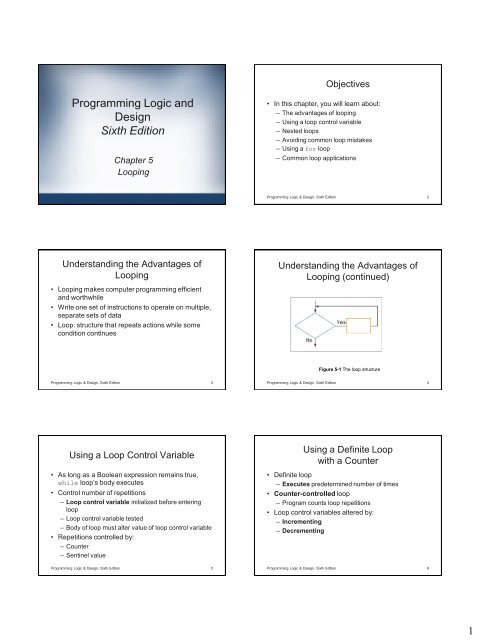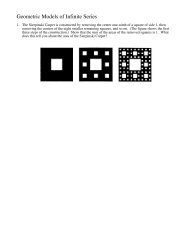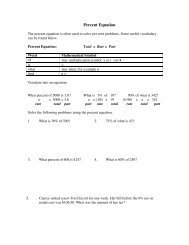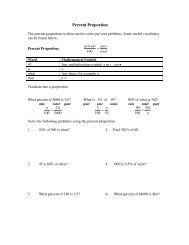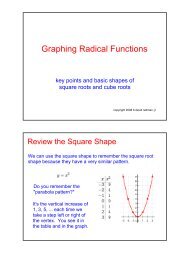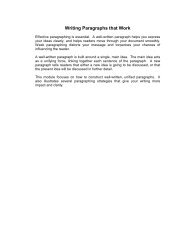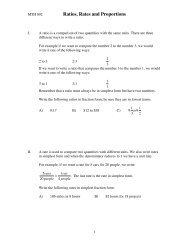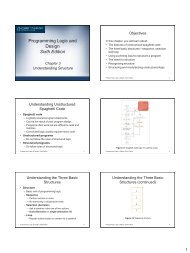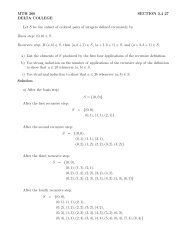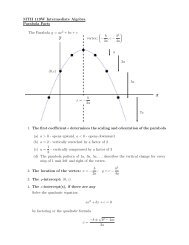Programming Logic and Design Sixth Edition
Programming Logic and Design Sixth Edition
Programming Logic and Design Sixth Edition
You also want an ePaper? Increase the reach of your titles
YUMPU automatically turns print PDFs into web optimized ePapers that Google loves.
Objectives<strong>Programming</strong> <strong>Logic</strong> <strong>and</strong><strong>Design</strong><strong>Sixth</strong> <strong>Edition</strong>Chapter 5Looping• In this chapter, you will learn about:– The advantages of looping– Using a loop control variable– Nested loops– Avoiding common loop mistakes– Using a for loop– Common loop applications<strong>Programming</strong> <strong>Logic</strong> & <strong>Design</strong>, <strong>Sixth</strong> <strong>Edition</strong> 2Underst<strong>and</strong>ing the Advantages ofLooping• Looping makes computer programming efficient<strong>and</strong> worthwhile• Write one set of instructions to operate on multiple,separate sets of data• Loop: structure that repeats actions while somecondition continuesUnderst<strong>and</strong>ing the Advantages ofLooping (continued)Figure 5-1 The loop structure<strong>Programming</strong> <strong>Logic</strong> & <strong>Design</strong>, <strong>Sixth</strong> <strong>Edition</strong> 3<strong>Programming</strong> <strong>Logic</strong> & <strong>Design</strong>, <strong>Sixth</strong> <strong>Edition</strong> 4Using a Loop Control Variable• As long as a Boolean expression remains true,while loop’s body executes• Control number of repetitions– Loop control variable initialized before enteringloop– Loop control variable tested– Body of loop must alter value of loop control variable• Repetitions controlled by:– Counter– Sentinel value<strong>Programming</strong> <strong>Logic</strong> & <strong>Design</strong>, <strong>Sixth</strong> <strong>Edition</strong> 5Using a Definite Loopwith a Counter• Definite loop– Executes predetermined number of times• Counter-controlled loop– Program counts loop repetitions• Loop control variables altered by:– Incrementing– Decrementing<strong>Programming</strong> <strong>Logic</strong> & <strong>Design</strong>, <strong>Sixth</strong> <strong>Edition</strong> 61
Using a Definite Loopwith a Counter (continued)Using an Indefinite Loopwith a Sentinel Value• Indefinite loop– Performed a different number of times each time theprogram executes• Three crucial steps– Starting value to control the loop must be provided– Comparison must be made using the value thatcontrols the loop– Within the loop, value that controls the loop must bealteredFigure 5-3 A counted while loop that outputs “Hello” four times<strong>Programming</strong> <strong>Logic</strong> & <strong>Design</strong>, <strong>Sixth</strong> <strong>Edition</strong> 7<strong>Programming</strong> <strong>Logic</strong> & <strong>Design</strong>, <strong>Sixth</strong> <strong>Edition</strong> 8Underst<strong>and</strong>ing the Loop in aProgram’s Mainline <strong>Logic</strong>• Three steps that should occur in every properlyfunctioning loop– Provide a starting value for the variable that willcontrol the loop– Test the loop control variable to determine whetherthe loop body executes– Alter the loop control variableFigure 5-4 An indefinite while loop that displays “Hello” as long as the userwants to continue<strong>Programming</strong> <strong>Logic</strong> & <strong>Design</strong>, <strong>Sixth</strong> <strong>Edition</strong> 9<strong>Programming</strong> <strong>Logic</strong> & <strong>Design</strong>, <strong>Sixth</strong> <strong>Edition</strong> 10Nested Loops• Nested loops: loops within loops• Outer loop: loop that contains the other loop• Inner loop: loop that is contained• Needed when values of two (or more) variablesrepeat to produce every combination of valuesFigure 5-8 Flowchart <strong>and</strong> pseudocode for AnswerSheet program<strong>Programming</strong> <strong>Logic</strong> & <strong>Design</strong>, <strong>Sixth</strong> <strong>Edition</strong> 11 <strong>Programming</strong> <strong>Logic</strong> & <strong>Design</strong>, <strong>Sixth</strong> <strong>Edition</strong> 122
Avoiding Common Loop Mistakes• Neglecting to initialize the loop control variable• Neglecting to alter the loop control variable• Using the wrong comparison with the loop controlvariable• Including statements inside the loop that belongoutside the loopAvoiding Common Loop Mistakes(continued)• Mistake: neglecting to initialize the loop controlvariable– Example: get name statement removed• Value of name unknown or garbage• Program may end before any labels printed• 100 labels printed with an invalid name<strong>Programming</strong> <strong>Logic</strong> & <strong>Design</strong>, <strong>Sixth</strong> <strong>Edition</strong> 13<strong>Programming</strong> <strong>Logic</strong> & <strong>Design</strong>, <strong>Sixth</strong> <strong>Edition</strong> 14Avoiding Common Loop Mistakes(continued)• Mistake: neglecting to alter the loop control variable– Remove get name instruction from outer loop• User never enters a name after the first one• Inner loop executes infinitely• Always incorrect to create a loop that cannotterminateFigure 5-10 Incorrect logic for greeting program because the loop controlvariable initialization is missing<strong>Programming</strong> <strong>Logic</strong> & <strong>Design</strong>, <strong>Sixth</strong> <strong>Edition</strong> 15<strong>Programming</strong> <strong>Logic</strong> & <strong>Design</strong>, <strong>Sixth</strong> <strong>Edition</strong> 16Avoiding Common Loop Mistakes(continued)• Mistake: using the wrong comparison with the loopcontrol variable– Programmers must use correct comparison– Seriousness depends on actions performed within aloop• Overcharge insurance customer by one month• Overbook a flight on airline application• Dispense extra medication to patients in pharmacyFigure 5-10 Incorrect logic for greeting program because the loop controlvariable is not altered<strong>Programming</strong> <strong>Logic</strong> & <strong>Design</strong>, <strong>Sixth</strong> <strong>Edition</strong> 17<strong>Programming</strong> <strong>Logic</strong> & <strong>Design</strong>, <strong>Sixth</strong> <strong>Edition</strong> 183
Avoiding Common Loop Mistakes(continued)• Mistake: including statements inside the loop thatbelong outside the loop– Example: discount every item by 30 percent– Inefficient because the same value is calculated 100separate times for each price that is entered– Move outside loop for efficiencyFigure 5-12 Incorrect logic for greeting program because the wrong test ismade with the loop control variable<strong>Programming</strong> <strong>Logic</strong> & <strong>Design</strong>, <strong>Sixth</strong> <strong>Edition</strong> 19<strong>Programming</strong> <strong>Logic</strong> & <strong>Design</strong>, <strong>Sixth</strong> <strong>Edition</strong> 20Figure 5-13 Inefficient way to produce 100 discount price stickers fordifferently priced items<strong>Programming</strong> <strong>Logic</strong> & <strong>Design</strong>, <strong>Sixth</strong> <strong>Edition</strong> 21Figure 5-14 Improved discount sticker-making program<strong>Programming</strong> <strong>Logic</strong> & <strong>Design</strong>, <strong>Sixth</strong> <strong>Edition</strong> 22Using a for Loop• for statement or for loop is a definite loop• Provides three actions in one structure– Initializes– Evaluates– Increments• Takes the form:for loopControlVariable = initialValue tofinalValue step stepValuedo somethingendforUsing a for Loop (continued)• Examplefor count = 0 to 3 step 1output “Hello”endfor• Initializes count to 0• Checks count against the limit value 3• If evaluation is true, for statement body prints thelabel• Increases count by 1<strong>Programming</strong> <strong>Logic</strong> & <strong>Design</strong>, <strong>Sixth</strong> <strong>Edition</strong> 23<strong>Programming</strong> <strong>Logic</strong> & <strong>Design</strong>, <strong>Sixth</strong> <strong>Edition</strong> 244
Using a for Loop (continued)• while statement could be used in place of forstatement• Step value: number used to increase a loopcontrol variable on each pass through a loop– <strong>Programming</strong> languages can:• Require a statement that indicates the step value• Have a step value default of 1• Specify step value when each pass through theloop changes the loop control variable by valueother than 1Common Loop Applications• Using a loop to accumulate totals– Examples• Business reports often include totals• List of real estate sold <strong>and</strong> total value• Accumulator: variable that gathers values– Similar to a counter• Counter increments by one• Accumulator increments by some value<strong>Programming</strong> <strong>Logic</strong> & <strong>Design</strong>, <strong>Sixth</strong> <strong>Edition</strong> 25<strong>Programming</strong> <strong>Logic</strong> & <strong>Design</strong>, <strong>Sixth</strong> <strong>Edition</strong> 26Common Loop Applications(continued)• Accumulate total real estate prices– Declare numeric variable at beginning– Initialize the accumulator to 0– Read each transaction’s data record– Add its value to accumulator variable– Read the next record until eof• Variables exist only for the life of the application– Run the application a second time; variables occupydifferent memory locationCommon Loop Applications(continued)Figure 5-16 Month-end real estate sales report<strong>Programming</strong> <strong>Logic</strong> & <strong>Design</strong>, <strong>Sixth</strong> <strong>Edition</strong> 27<strong>Programming</strong> <strong>Logic</strong> & <strong>Design</strong>, <strong>Sixth</strong> <strong>Edition</strong> 28Common Loop Applications(continued)Figure 5-17 Flowchart <strong>and</strong> pseudocode for real estate sales report program<strong>Programming</strong> <strong>Logic</strong> & <strong>Design</strong>, <strong>Sixth</strong> <strong>Edition</strong> 29• Using a loop to validate data– When prompting a user for data, no guarantee thatdata is valid• Validate data: make sure data falls in acceptableranges• Example: user enters birth month– If number is less than 1 or greater than 12• Display error message <strong>and</strong> stop the program• Assign default value for the month• Reprompt the user for valid input<strong>Programming</strong> <strong>Logic</strong> & <strong>Design</strong>, <strong>Sixth</strong> <strong>Edition</strong> 305
Figure 5-18 Reprompting a user once after an invalid month is entered<strong>Programming</strong> <strong>Logic</strong> & <strong>Design</strong>, <strong>Sixth</strong> <strong>Edition</strong> 31Figure 5-19 Reprompting a user continuously after an invalid month is entered<strong>Programming</strong> <strong>Logic</strong> & <strong>Design</strong>, <strong>Sixth</strong> <strong>Edition</strong> 32Common Loop Applications(continued)• Limiting a reprompting loop– Reprompting can be frustrating to a user if itcontinues indefinitely– Maintain count of the number of reprompts– Forcing a data item means:• Override incorrect data by setting the variable to aspecific valueCommon Loop Applications(continued)• Validating a data type– Validating data requires a variety of methods– isNumeric() or similar method• Provided with the language translator you use to writeyour programs• Black box– isChar() or isWhitespace()– Accept user data as strings– Use built-in methods to convert to correct data types<strong>Programming</strong> <strong>Logic</strong> & <strong>Design</strong>, <strong>Sixth</strong> <strong>Edition</strong> 33<strong>Programming</strong> <strong>Logic</strong> & <strong>Design</strong>, <strong>Sixth</strong> <strong>Edition</strong> 34Common Loop Applications(continued)Common Loop Applications(continued)• Validating reasonableness <strong>and</strong> consistency of data– Many data items can be checked for reasonableness– Good defensive programs try to foresee all possibleinconsistencies <strong>and</strong> errorsFigure 5-21 Checking data for correct type<strong>Programming</strong> <strong>Logic</strong> & <strong>Design</strong>, <strong>Sixth</strong> <strong>Edition</strong> 35<strong>Programming</strong> <strong>Logic</strong> & <strong>Design</strong>, <strong>Sixth</strong> <strong>Edition</strong> 366


